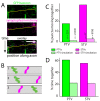Coordinated trafficking of synaptic vesicle and active zone proteins prior to synapse formation
- PMID: 21569270
- PMCID: PMC3103415
- DOI: 10.1186/1749-8104-6-24
Coordinated trafficking of synaptic vesicle and active zone proteins prior to synapse formation
Abstract
Background: The proteins required for synaptic transmission are rapidly assembled at nascent synapses, but the mechanisms through which these proteins are delivered to developing presynaptic terminals are not understood. Prior to synapse formation, active zone proteins and synaptic vesicle proteins are transported along axons in distinct organelles referred to as piccolo-bassoon transport vesicles (PTVs) and synaptic vesicle protein transport vesicles (STVs), respectively. Although both PTVs and STVs are recruited to the same site in the axon, often within minutes of axo-dendritic contact, it is not known whether or how PTV and STV trafficking is coordinated before synapse formation.
Results: Here, using time-lapse confocal imaging of the dynamics of PTVs and STVs in the same axon, we show that vesicle trafficking is coordinated through at least two mechanisms. First, a significant proportion of STVs and PTVs are transported together before forming a stable terminal. Second, individual PTVs and STVs share pause sites within the axon. Importantly, for both STVs and PTVs, encountering the other type of vesicle increases their propensity to pause. To determine if PTV-STV interactions are important for pausing, PTV density was reduced in axons by expression of a dominant negative construct corresponding to the syntaxin binding domain of syntabulin, which links PTVs with their KIF5B motor. This reduction in PTVs had a minimal effect on STV pausing and movement, suggesting that an interaction between STVs and PTVs is not responsible for enhancing STV pausing.
Conclusions: Our results indicate that trafficking of STVs and PTVs is coordinated even prior to synapse development. This novel coordination of transport and pausing might provide mechanisms through which all of the components of a presynaptic terminal can be rapidly accumulated at sites of synapse formation.
Figures







References
-
- Washbourne P, Bennett JE, McAllister AK. Rapid recruitment of NMDA receptor transport packets to nascent synapses. Nat Neurosci. 2002;5:751–759. - PubMed
Publication types
MeSH terms
Substances
LinkOut - more resources
Full Text Sources
Miscellaneous

